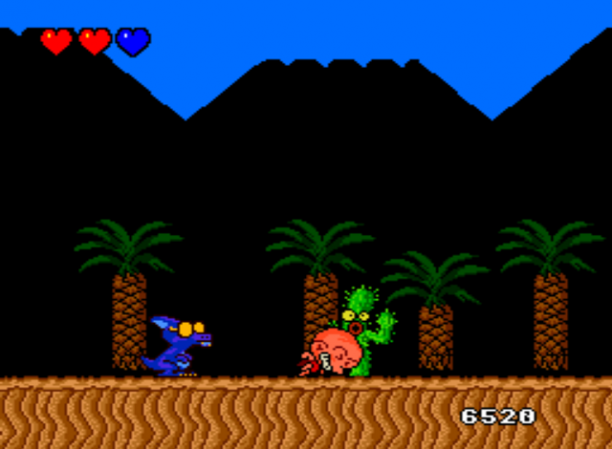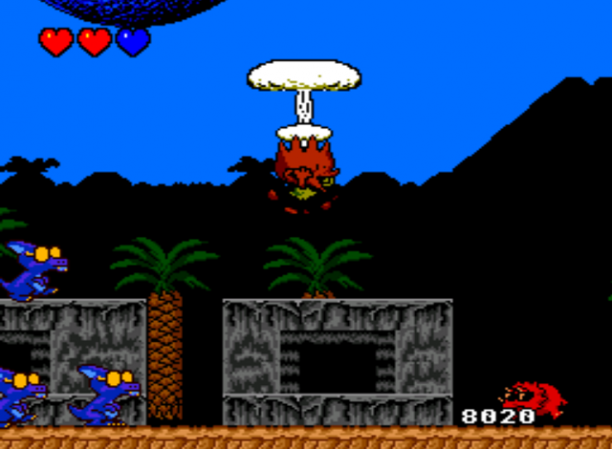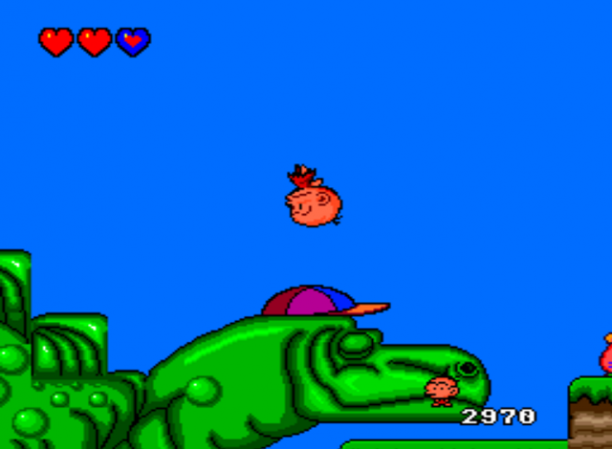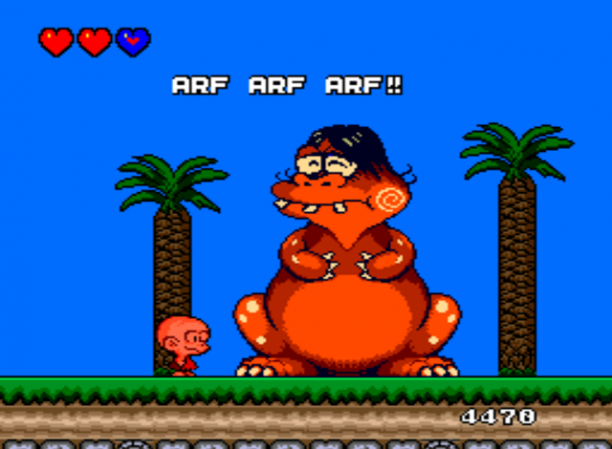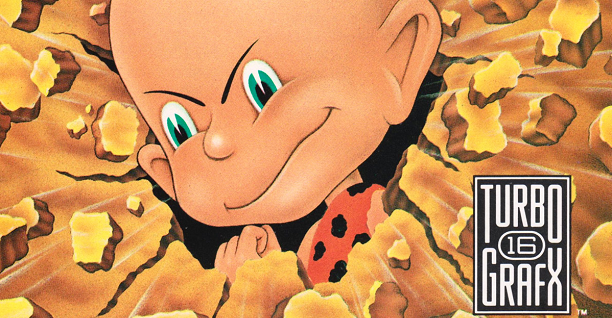
Pixel Gallery
Bonk’s Adventure
Retro Platforms: Amiga, Arcade, Game Boy, NES, TurboGrafx-16
Platform Reviewed: TurboGrafx-16
Although the fourth generation of video game consoles tends to be remembered as a battle between the Super Nintendo and Sega Genesis, a lesser-known combatant was the TurboGrafx-16. The result of a collaborative development between Hudson Soft and NEC Corporation, the system supported almost 500 simultaneous colors in-game, used card-like game cartridges, allowed five players at once, and had six entire wavetable synthesis audio channels; if that last point didn’t get you totally excited, then maybe seeing its various fast-paced shooters will. Several classics originated on the TurboGrafx-16 as well, such as the disturbing Crush Pinball series, most of the intense Star Soldier franchise, and the whimsical Bonk games. Bonk’s Adventure, the first entry in the system’s prehistoric mascot series, is how I first learned about the TurboGrafx-16, but does it do the system justice?
Graphics
Regarding the art style of Bonk’s Adventure, the game is wildly imaginative and satisfying to explore. Everything is themed around prehistoric environments, with some additional locations on top of that: claustrophobic caves, speedy ice terrains, underwater springs… and then you also have dinosaur insides and moon surfaces… because video games. The coloring is the strongest aspect of the game’s graphics: colors stand out from one another, have sparking aspects, illustrate environmental obstacles, and generally have an upbeat and bright nature to them! There’s a large focus on tropical settings, which thematically fits the dangers that Bonk faces, and the differing environment types successfully convey new mechanics to the player. The only major criticisms that I have with the game’s visuals are with some backdrops: many of them are only single colors, and a lack of noticeable parallax scrolling makes some grounds feel flat and not distanced far enough from one another. These background limitations aren’t apparent in a few levels though, and there are occasional sky details at least.
Every character is elaborately drawn and fluidly animated, with each enemy having their own personality and charm, and Bonk having visual distinctions between his various appearances. Additionally, enemies have amusing responses to being hit, such as flowers looking furious for a split second while being stomped on, and bosses having visible personality changes after being defeated. Bonk especially has an impressively high number of possible reactions: he cringes when slamming into the ground, shows a sugar-high response to eating meat, has multiple ways of humorously expressing pain, disturbingly foams at the mouth when dying, and there are many other examples that I can’t fit into a single paragraph. I don’t remember Bonk’s Adventure having any real lag either, and while the game’s camera is centered, I was usually able to properly react to enemies in time.
Audio
Some of the music can take a while to get stuck in your head, and many tracks are repeated across multiple levels, but they’re consistently upbeat and positive in a way that matches their respective environments. What I really like about the game’s music is how it’s able to convey a seriousness in some situations, but without sacrificing any sort of cheerful nature; even the bosses manage to have intense introductions while also not being seriously distressing. Much like the graphics, tribal themes are also worked into the audio: ritualistic percussion patterns play in the backgrounds, and many songs are divided into short yet catchy sections that slightly escalate over time. Tracks do repeat after small amounts of time, but I can easily excuse this due to how generally appropriate and positive the overall music is; it really improves my mood while playing!
Like the music, the game’s sound effects are also very bright and full of life, although they’re simpler on a technical level and occasionally seem like they cut off early. Some movements sound a little repetitive, and after playing the first few stages, there aren’t too many new noises to continuously diversify things up. However, everything works pretty well and manages to complement gameplay actions; to list a few examples, there’s a sharp alert in response to pain, airborne spinning noises perfectly match Bonk’s movements, climbing (or in Bonk’s case, chomping) up a cliff sounds satisfying, and noises from collecting fruits continue from the end of the sound that attacking a plant makes. Probably the most amusing sound effects are the transition sounds for Bonk eating meat: they build into a steam-like noise, and the melody for Bonk’s final form is invigorating.
Gameplay
Bonk’s Adventure may seem like a typical side-scroller on the surface, but almost the entirety of its gameplay mechanics revolve around one unique theme: hardcore head-banging action! By quite literally banging your head against things, many of the game’s enemies are defeated by hitting them with your noggin, but there are many creative ways to do this: grounded foes can be horizontally knocked, airborne creatures can be dived into, many monsters can be hit from underneath, and you can mix and match the moves as you see fit. A particularly fun (and encouraged) challenge is bopping an enemy into the air, followed by repeatedly hitting them upwards as you try to earn point bonuses. If you have a turbo controller, then something particularly exciting you can try is repeatedly spinning around in the air; this lets you glide downwards, although it also means you’ll take damage from about half of any enemy collisions. Jumping strategies are needed most during boss battles, and once you nail down how to repeatedly chain downward head-dives, the feedback to your actions feels great!
There’s a lot to like about this game, but let’s just get some bigger cons out of the way. While movements function well enough in open environments, the jumping controls can feel pretty stiff, and there’s also a lack of fluidity to some actions; at least you can adjust your jump’s height though. Running off platforms also makes you fall straight down instead of forward, which halts momentum in a way that awkwardly limits your sense of speed. The other natural controls that you have include chomping up certain cliffs, shaking off enemies that bite you, and swimming around in aquatic areas; the last of these works pretty well when you’re able to head-butt enemies, but when facing environmental obstacles, sometimes the areas are too tight and your movements are too slow to navigate around them in time. Climbing cliffs also feels too slow, but it’s not required very often.
Thankfully, the head-based controls are pretty solid, and there’s also a creative power-up mechanic in the form of hidden or enemy-dropped meat. You start as normal Bonk, and eating a small piece of meat makes your attacks stronger and gives you an extremely useful stun attack: dive into the ground, and non-boss enemies will temporarily turn into stones that cannot hurt you. Eat another piece of meat, or initially have eaten a larger piece of meat, and you evolve into Bonk’s hyperactive form, where he becomes even stronger, moves faster, and is temporarily invincible from enemies (and some environmental obstacles). These forms naturally wear off over time, and that many of these are prizes gives you a great incentive to hunt them down! The game provides a risk versus reward system to facing enemies, something also reflected via certain point multiples granting extra lives.
Naturally, lives are lost by running out of health, but the game offers various ways to heal: dropped or secret hearts heal whole fragments, scattered crops (which are usually found from spring-like flowers) heal fractions of hearts, and collected smiley faces are exchanged for points and health refills at the ends of worlds. The game’s health system is generous enough to forgive simple mistakes, and the game’s also challenging yet well-curved enough to make hunting for items a fun task. In precisely two instances, Bonk can also find blue flowers that increase his life meter, but it’s a little unfortunate that the bonuses don’t carry over with continues, which will happen at least several times near the end of the game. Even when plants are common, Bonk’s Adventure encourages you to remain attentive, as some flowers (with fair warning) will actually attack back! Dying, which involves a morbid depiction of Bonk rolling around and foaming from his mouth, lets you choose when to use a life on the spot, although running out makes you have to restart from the world’s start (or endgame boss rush); this checkpoint system is appreciated, although it doesn’t account each world having a different level count.
The overall stage design varies often enough to keep gameplay entertaining and environments diverse. For starters, a number of stages have multiple paths, such as an earlier level that encourages rapidly jumping on waterfalls, which is above a rocky area that lies above a swimming section. One level even has a collapsing bridge segment that lets you skip a few levels if you’re extremely cautious! New mechanics are tried on individual levels, such as momentum-building vines and climbable trees in jungles, ice friction and sliding blocks (that can be ridden) in snow areas, and some worlds have clouds that can be wildly bounced across. Many levels also have hidden bonus levels, although their entrances aren’t initially obvious until you realize what they look like; challenges in these levels are structured like mini-games, such as climbing a cliff as high as possible in a short amount of time. The bonus levels aren’t significant, but they’re fun little surprises with their own rewards.
Bosses appear at the ends of worlds, and while most of them are fun, there are individual things that bother me. Every encounter typically encourages aerial head-butt chains; you can hit some bosses with jumps from underneath, but this isn’t always possible. The first boss is well-designed since he moves in a way that makes it easy to get above him, but later bosses start to add mechanics that border on crossing the balance between fair challenge and unfair cheapness: the second boss has a trial-and-error clone mechanic that’s totally random, the third boss’s head-based weak point is too small (without hitting his arms) for the stiff controls, and the fourth boss has fairly random dash attacks that take away a significant amount of your health. I can overlook these for the most part, but I cannot ignore the final boss, who is extremely irritating to face: you’re damaged every single time you hurt him unless you land on a really specific area on his nose, but the hitbox for this is small, and the game never makes it clear where that spot is. And since this boss also moves quickly and spawns enemies, you might as well just abuse damaged-based invincibility, spam jumps from underneath, and hope for the best.
Conclusion
Bonk’s Adventure definitely has some recurring control issues, even if they’re not game-breaking: ground-based movements lack fluidity, climbing and swimming have more cons than pros, and the overall controls are somewhat stiff. If you can look past random boss oddities and these control limitations, however, then you’ll find an incredibly fun and charming game that manages to be really entertaining with its creative head-based mechanics. Additionally, levels are diverse, in-game items (especially the meat) are fun to collect, and hidden yet satisfying secrets are aplenty. But what I love most is the game’s upbeat presentation: the characters have elaborate reactions, the music is seriously uplifting, and the bright coloring really strengthens the art style! If nothing else, Bonk’s Adventure helps cheer me up, and that alone definitely makes it worth playing for me.
